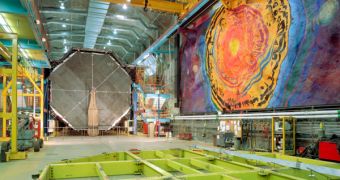The Main Injector Neutrino Oscillation Search (MINOS) telescope detector, buried some 700 meters (2,200 feet) below the surface of Soudan, Minnesota, offered its operators a surprise recently, when it proved that it could interpret decays from the stratosphere (which is the upper layer of the atmosphere) and superimpose it on data gathered from balloon weather stations and satellite readings. Basically, what the telescope does is that it can capture decayed particles of cosmic rays, and, depending on their energy, tell if the conditions high above are dangerous.
Climate experts have long since noticed that the upper layers of the atmosphere, where storm clouds are not regularly born, have a very high influence on the layers below, and have thus determined that the best way to go about forecasting weather is to get an insight on what's happening in the stratosphere. MINOS can do just that, although it lies at the bottom of an old mining tunnel, surrounded by hundreds of tons of rocks.
It works by analyzing the particles that form the cosmic rays. When these particles hit the stratosphere, they decay to pions, unstable elements resulted from the collision of the rays with atoms in our atmosphere. If they can avoid being destroyed by atoms above our planet, and are also energetic enough, the pions will decay into muons, which can sometimes penetrate as deep as the place where MINOS is located.
While the telescope was first built to analyze the flow of particles called neutrinos through our planet, it also proved more than capable to handle muons as well. "The interesting thing is you can actually monitor [this] half a mile underground just by looking at this cosmic ray muon data," says Scott Osprey, the lead author of a new paper detailing the find. Osprey is working at the National Centre for Atmospheric Science in Oxford, UK.
He says that there are much more muons coming in when the atmosphere is warmer, which would seem to suggest that heat loosens the gases in the stratosphere and allows more pions to pass through. Adversely, when it’s cold in the upper part of the atmosphere, less pions get through and end up as muons. By relating this data with that gathered from weather balloons and satellites, the system could prove an invaluable tool in long-term weather forecasting.
"We already have an extensive balloon network [measuring temperatures] around the globe. Satellite instruments also provide global profile measurements that are good to 1 °C," says NASA's Goddard Space Flight Center researcher Paul Newman, from Greenbelt, Maryland. He adds that the technique is not convincing enough, and that it could never rival direct atmospheric observation.
"The only limitation is the size of your detector," counteracts Osprey, saying that future equipments could have an even greater accuracy than MINOS in predicting weather, even to an error index lower than 1 °C.

 14 DAY TRIAL //
14 DAY TRIAL //